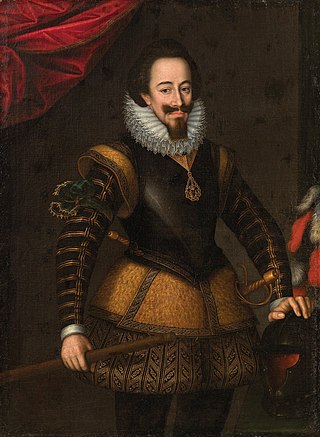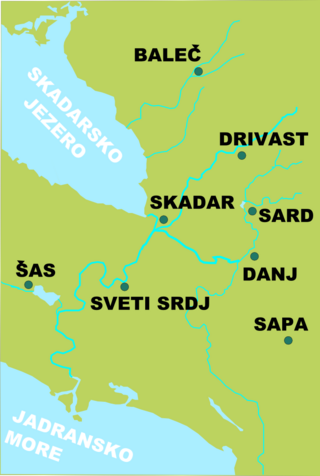Related Research Articles

Charles Emmanuel I, known as the Great, was the Duke of Savoy and ruler of the Savoyard states from 30 August 1580 until his death almost 50 years later in 1630, he was the longest-reigning Savoyard monarch at the time, only for his record to be surpassed by his great-grandson Victor Amadeus II. He was nicknamed Testa d'feu for his rashness and military aggression.

Kelmendi is a historical Albanian tribe (fis) and region in Malësia and eastern Montenegro. It is located in the upper valley of the Cem river and its tributaries in the Accursed Mountains range of the Dinaric Alps. The Vermosh river springs in the village of the same name, which is Albania's northernmost village. Vermosh pours into Lake Plav.

Gruda is a Northern Albanian tribe and historical tribal region in southeastern Montenegro, just north of Lake Skadar, which includes the small town of Tuzi, in Podgorica. It is inhabited by a majority of ethnic Albanians.
Abaz Dilaver Çelkupa or Abaz Efendi Çelkupa was an Albanian politician and one of the delegates and signatories of the Albanian Declaration of Independence in 1912. He was among the key activists of the Albanian National Awakening.
The Battle of Vajkal or Battle of Valkal was fought in April of 1465 between the Albanian forces of Skanderbeg and an Ottoman army under Ballaban Pasha, an Ottoman commander of Albanian origin. Ballaban Badera, the new Ottoman sanjakbey of the Sanjak of Ohrid, was sent by Sultan Mehmed II to attack Albanian forces. The Albanians were ultimately victorious, but both sides suffered heavy losses. Some of Skanderbeg's officers were captured by the fleeing Ottomans and were then summarily executed.

Dagnum was a town, bishopric and important medieval fortress located on the territory of present-day Albania, which has been under Albanian, Serbian, Venetian and Ottoman control and remains a Latin Catholic titular see. It is close to the modern day town of Vau i Dejës.

Zadrima is an ethnographic region situated in north-western Albania between the cities of Shkodra and Lezha, located left of the Lower Drin which eventually drains into the Adriatic Sea from near Lezha.

The House of Dukagjini is an Albanian noble family which ruled over an area of Northern Albania and Western Kosovo known as the Principality of Dukagjini in the 14th and 15th centuries. They may have been descendants of the earlier Progoni family, who founded the first Albanian state in recorded history, the Principality of Arbanon. The city of Lezhë was their most important holding.
Lale Drekalov was a vojvoda of the Kuči tribe in eastern Montenegro in the first half of the 17th century.

Nikollë Mekajshi was a Franciscan Roman Catholic prelate who served as bishop of Stephanium, a region in central Albania. He took part in the Convention of Mat in 1594, and was a member of the delegation that negotiated with Pope.
Nicholas Dukagjini was a 15th-century member of the Dukagjini family.

Berisha is a historical Albanian tribe (fis) and region in Pukë, northern Albania. Berisha is one of the oldest documented Albanian tribes, first recorded in 1242 in Dulcigno. In the Middle Ages, it was widely spread across northern Albania, southern Montenegro and Kosovo. People who traced their origin to Berisha are also found in the coastal trading hubs of Dalmatia in the Middle Ages. Berisha formed its own territorial community in Pukë in the course of the 14th century.
Brda refers to a historical and ethnographical region in Montenegro. The Brda are one of the country's four historic tribal regions, along with Old Montenegro, Old Herzegovina and the Montenegrin Littoral. The historical tribes of the Brda are the Vasojevići, the Bjelopavlići, the Piperi, the Kuči, the Bratonožići, the Moračani and the Rovčani. Collectively known as "the seven tribes" or "the seven hills", they were referred to as "Highlander tribes" before their gradual integration into Montenegro, from the late 18th to the early 20th century. As a result, members of these tribes are also often called "Highlanders".
Grdan was the vojvoda (duke) of the Nikšić nahija, part of the Sanjak of Herzegovina, who led several uprisings against the Ottomans in between 1596 and 1612, alongside Serbian Patriarch Jovan Kantul.

The Principality of Dukagjini refers to the domains (zotërimet) of the Albanian Dukagjini family in northern Albania and western part of the modern-day territory of Kosovo in the 14th century and 15th century. At their maximum extent, the domains of the Dukagjini extended from Upper Zadrima in the northwest to the Plain of Dukagjini in western Kosovo. The political center of the Dukagjini family was Lezhë until 1393 when it was surrendered to Venice in order to not fall under the Ottomans. The Ottoman sanjak of Dukagjin was named after the rule of the family in the areas that formed it.
The Convention of Mat was organized on 7 November 1594 by Albanian leaders fighting against the Ottoman Empire. Mat was chosen as the place of the meeting due to its role in Albanian revolts of the 16th century. The aim was a better organization of the revolts to achieve independence from the Ottoman Empire. The convention decided that help should be sought from the Pope, and for negotiations were chosen Tom Plezha, Mark Gjini and Nikollë Mekajshi. However, the Pope refused to give help, claiming that it was not the right time to fight the Ottoman Empire. Another decision of Albanian leaders was to not let the Republic of Venice know about their plans as the latter did not want to open a new conflict with the Ottomans. The news came out and Venetians managed to divide the organizers of the convention between themselves. In the following two years, Albanian leaders continued their work to get help from Christian powers, taking heart from geopolitical circumstances. In 1596, 10,000 men marched towards Vlora in hope of receiving arms from Spain but the arms sent were confiscated by Venetians. The events damaged the relations between Albanian leaders and Christian powers but did not weaken the efforts for independence.
Tom Plezha was an Albanian leader chosen at the Convention of Mat to negotiate with the Pope an alliance against the Ottoman Empire.
Mark Gjini was an Albanian leader chosen at the Convention of Mat to negotiate with the Pope an alliance against the Ottoman Empire.
The Convention of Kuçi was an interregional assembly held on July 14–15, 1614, in the area of the Kuçi tribe in the region of Malësia in modern northernmost Albania and Montenegro. A second assembly was held on September 8, 1614, which reaffirmed the decisions of the July assembly and also had an enlarged participation. Of the 44 representatives of the first assembly, almost all were from the Albanian tribes and the tribes of Montenegro. Several representatives of tribes are mentioned in the reports of the decisions of the assembly like Gjergj Bardhi from Mirdita and Gjin Gjergji from Dukagjin.
At the conclusion of the Albanian-Ottoman Wars in the 15th century, the Albanian people revolted against the Ottoman Empire. These actions during this time continued an extended period of conquest and border expansion into Southeastern Europe. The Ottomans were left in control of all the main Albanian cities, besides Durrës and Ulcinj, which were still controlled by the Venice. Albania would be ruled by the Ottomans for over 400 years, but this rule would be frequently disrupted by revolts and uprisings with varying degrees of success.
References
- ↑ The International Journal of Albanian Studies. Department of Political Science, Columbia University. 1997. p. 61. Retrieved 31 March 2020.
- ↑ TETAJ, Luan. Inter-Balkan Councils and Albanians during the 16th and 17th century. Universiteti i Prishtinës "Hasan Prishtina" Fakulteti Filozofik Departamenti: Historisë. p. 4. Archived from the original on 28 July 2020. Retrieved 31 March 2020.
- ↑ Tetaj, PhD (C.) Luan (2017). Institute of History "Ali Hadri" – Kosovo (PDF) (VOL 3 ed.). Graz-Austria: Academic Journal of Business, Administration, Law and Social Sciences IIPCCL Publishing. p. 217. Retrieved 31 March 2020.
- ↑ Studia Albanica (in French). 1966. p. 180. Retrieved 31 March 2020.
- ↑ Frashëri, Kristo (1964). The History of Albania: A Brief Survey. na. p. 94.
- ↑ Problems of the Formation of the Albanian People, Their Language, and Culture: (selection). "8 Nëntori" Publishing House. 1984. p. 343. Retrieved 31 March 2020.
- ↑ Jaho, Brahaj. Heraldika Shqiptare (Albanian Heraldry) (PDF). Archived from the original (PDF) on 4 March 2016. Retrieved 31 March 2020.
- ↑ Maletić, Mihailo (1937). Kosovo nekad i danas (in Russian). p. 139. Retrieved 31 March 2020.
- ↑ Beck, Hans Georg; Schmaus, Alois (1970). Beiträge zur Südosteuropa-Forschung: Anlässlich des 2. Internationalen Balkanologenkongresses in Athen, 7.5.-13.5. 1970 im Auftrag des Arbeitskreises Südosteuropa-Forschung bei der Deutschen (in German) (Of these meetings, which had the character of pronounced notable meetings, 3 took place in 1594 in the S. Maria monastery in Mati, in 1598 in the Zadrima, in 1601 in Dukagjin, in 1608 in Moraca and Dukagjin and in 1614 in Kuci. ed.). Trofenik. p. 8. Retrieved 31 March 2020.